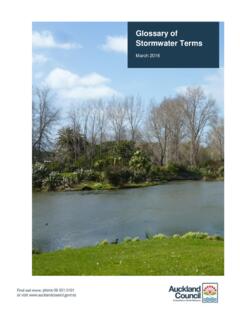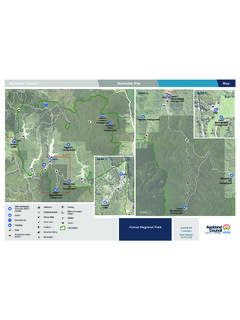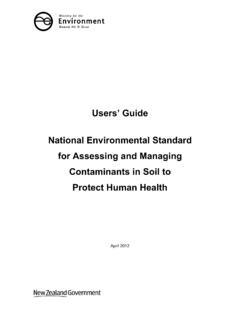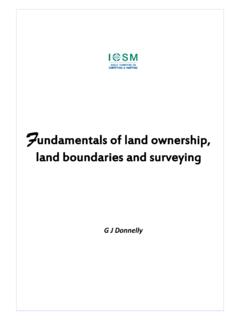Transcription of AC2231 Retaining walls - Auckland Council
1 Page 1 of 5 March 2019 AC2231 ( ) Document type: Practice Note Title: Retaining walls Document number: AC2231 Version: 5 1. Introduction The purpose of this practice note is to provide guidance about Retaining walls ; it provides information about when a building/resource consent is required and how they should be designed. The Building Act 2004 schedule 1, exempts some Retaining walls including Retaining walls built in rural zones from a building consent; however, these exemptions may breach other legislation such as the Resource Management Act 1991. 2. Building Act 2004 - Schedule 1 building work for which a consent is not required Schedule 1: Exemption 20 A building consent is not required for the construction or alteration of any Retaining wall that retains not more than metres depth of ground and does not support any surcharge or any load additional to the load of that ground (for example, the load of vehicles on a road).
2 Retaining wall - urban Is a building consent required? Retaining wall = or < m / no surcharge No Retaining wall = or < m / with surcharge Yes Retaining wall > m / with or without surcharge Yes Schedule 1: Exemption 41 Building work for which design is carried out or reviewed by chartered professional engineer (1) Building work in connection with a Retaining wall in a rural zone, if:- a) the wall retains not more than 3 metres depth of ground; and b) the distance between the wall and any legal boundary or existing building is at least the height of the wall (2) In subsection (1), rural zone means any zone or area (other than a rural residential area) that, in the District Plan of the Territorial Authority (the Council ) in whose district the building work is to be undertaken, is described as a rural zone, rural resource area, or rural environment, or by words of similar meaning.
3 Although a building consent may not be required, all building work must comply with the requirements of The new zealand Building Code. For example, clause requires that buildings, building elements and site work shall withstand the combination of loads that they are likely to experience during construction or alteration and throughout their lives. Important note: all building work must comply with other legislation this may mean that resource consent might be required even though a building consent is not. 3. Other legislation Under the Building Act 2004, a new section has been enacted, which must be considered before deciding whether building work is exempt, that is.
4 (2)(c) that the building work does not breach any other enactment Page 2 of 5 March 2019 AC2231 ( ) Example: resource consent is required because the work does not comply with the AUP; after the applicant obtains resource consent for the particular infringement, the building work reverts to being exempt from the need to obtain building consent. Auckland Unitary Plan (AUP) According to the AUP rural zoning rules, any Retaining wall that exceeds in height is regarded as a building. Therefore, all requirements under the AUP relating to a building, apply to a Retaining wall that exceeds in height. Please refer to Sections H19, 20 and 21 of the AUP for zone definitions.
5 4. What is a surcharge? Any vertical pressure applied to the ground surface in the vicinity of a Retaining wall is a surcharge. This surcharge load will result in an additional horizontal pressure on the Retaining wall. It is the responsibility of the designer/structural engineer to determine the appropriate surcharge that can reasonably be ascertained from the site condition for both during the construction stage and long-term condition in which the Retaining wall is to be built. Close proximity definition Where a Retaining wall is constructed in close proximity to a building or structure, the distance from the base of the building to the wall (retained area side of the wall) shall be equal to or less than the height of the Retaining wall (measured from the base of the foundation).
6 5. Design of Retaining walls on boundary for surcharge load If the owner of a property wishes to erect a Retaining wall on or close to the boundary of their site, they must design the wall to provide adequate support to the neighbouring site, and should also provide reasonable allowance for surcharge loadings likely to occur during the life of the structure. In particular, it is highly likely that the Retaining wall will incur a surcharge if there is potential for subdivision or other further development of the neighbouring site. The designer of the Retaining wall shall specify and design for the maximum surcharge loading likely to be experienced throughout the life of the structure (with reasons) and show that long-term lateral deflection of the wall will be within acceptable limits (in some cases, design for at rest soil pressure will be considered sufficient to address this deflection requirement).
7 Unless there is clearly a case for designing for a greater surcharge loading, Council will normally accept design for: kPa minimum surcharge loading if there is future potential for a right of way or access lot on the adjoining site kPa minimum surcharge loading in all other cases (this allows for up to about 300mm of loose filling placed on top of the ground behind the wall). In addition, the structural design shall include a construction methodology to ensure that the stability of any land on the adjoining site is fully protected. Note the wall including the drainage metal and sub-soil drain behind the wall must not cross the boundary at any point.
8 Commentary of the Building Code states that ..account shall be taken of all physical conditions likely to affect the stability of buildings, building elements and site Page 3 of 5 March 2019 AC2231 ( ) This implies that the Retaining wall design needs to consider likely loads. Likely loads have been previously defined by MBIE as loads known with reasonable certainty including planned activity such as anticipated loading from a subdivision (driveway). Council has engaged an engineering consultant (GHD) to ascertain the magnitude of the surcharge load which can be reasonably expected. The GHD report dated Feb 2005 concluded that a 12kPA surcharge is indeed reasonable.
9 It is equivalent to dead and live loads arising from a 2m wide driveway with a 100mm concrete slab at the vicinity of the Retaining wall. This is the basis of which Council has accepted that a 12kPA surcharge in the absence of any other reasonably proposed surcharge load for Retaining wall at the boundary is appropriate. Past Determinations Whilst there is no direct ruling from past determinations regarding the design to 12kPA surcharge on Retaining walls , such load magnitude has been quoted and appear acceptable (albeit indirectly) in site specific cases (see determinations 2015/003 and 2015/006). NZS 4229:2013 Concrete masonry Buildings not requiring specific engineering design There has been some confusion in the past regarding masonry Retaining wall designed to NZS 4229.
10 Details of the design are explained in Appendix A. Clause states that specific engineering design still needs to be provided if any one of the conditions (a)-(g) exists. In particular, (b) where the surcharge is above the limit specified in Fig. A2 which is In other words, the deem-to-comply design in Fig. A2 can be adopted without specific design if and only if the expected surcharge does not exceed It does not mean, however, that all surcharge loads must only be 6. Timber wall durability Council has in the past, required H6 treated timber for pole Retaining walls . The reason is to ensure that the Retaining wall would have an expected service life of at least 100 years.
















